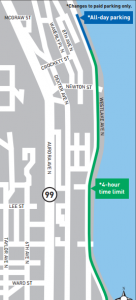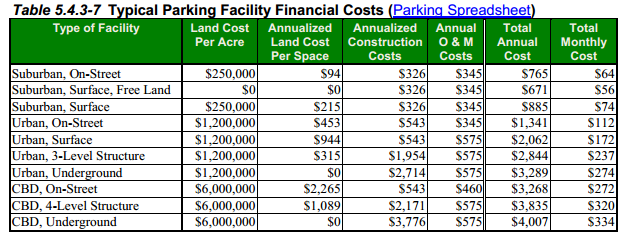 Changes To Parking On Westlake
Changes To Parking On Westlake
The Seattle Department of Transportation will be reducing it’s parking subsidy along Westlake this month. The city owns a tremendous amount of parking spaces along that were previously free to use all day. While there are many problems with free parking, it is frequently difficult to make parking more fair due to local push back.
Fortunately, the city has implemented studies to better understand parking utilization. Since there is a limited amount of space for parking, it is the goal of the city to ensure that there is always available space. The easiest way to do this is with time limits. Establishing a time limit in areas has been successful in garnering support from local business that see parking turnover as directly connected to sales at their business. Most recently SDOT studied the parking vacancy along Westlake avenue and discovered that occupancy rates averaged 85% during peak hours. Occupancy rates at this level indicate that it is often hard or impossible to find a parking space, essentially creating an obstacle to people trying to patronize businesses along Westlake. Before the change, the entire avenue allowed all day parking. After the change there will be a 4 hour limit south of Crockett Street. The area studied north of Crockett did not exceeded the target occupancy rate maximum of 85% and there will be no change, effectively continuing the subsidy as is. It is suspected that most of the parking along the street is from individuals commuting into the city and attempting to avoid paid parking in Uptown, Downtown or South Lake Union.
Subsidy Background
The 4 hour limit will definitely help business and the improvement should be applauded. Still, this change doesn’t entirely reduce the parking subsidy, nor does this mean the street is being used at it’s highest value. Estimates for on-street parking pin the annual cost around $128 a month per space*. If this program succeeds and the vacancy rate hits the middle of the city’s target, 77%, the revenue per space per month would be about $118. This is about an 8% subsidy on the spaces. Using this measurement, each hundred spaces result in subsidy of about $12,000 annually (as compared to $153,600 previously). To be clear, we support subsidies for transportation but only when the transportation is sustainable and benefits everyone. Additionally, it should be noted that the cost reference above ignores the many negative externalities of parking, including pollution, health effects, safety concerns and much more.
If you want to send a kind note to the people responsible for this please do. They overwhelming hear negative feedback when implementing changes like this even though it benefits almost everyone and a little positive reinforcement can help tremendously.
*Cost per space is taken from this estimate and adjusted to 2014 dollars using the CPI calculator.


Owen Pickford
Owen is a solutions engineer for a software company. He has an amateur interest in urban policy, focusing on housing. His primary mode is a bicycle but isn't ashamed of riding down the hill and taking the bus back up. Feel free to tweet at him: @pickovven.

